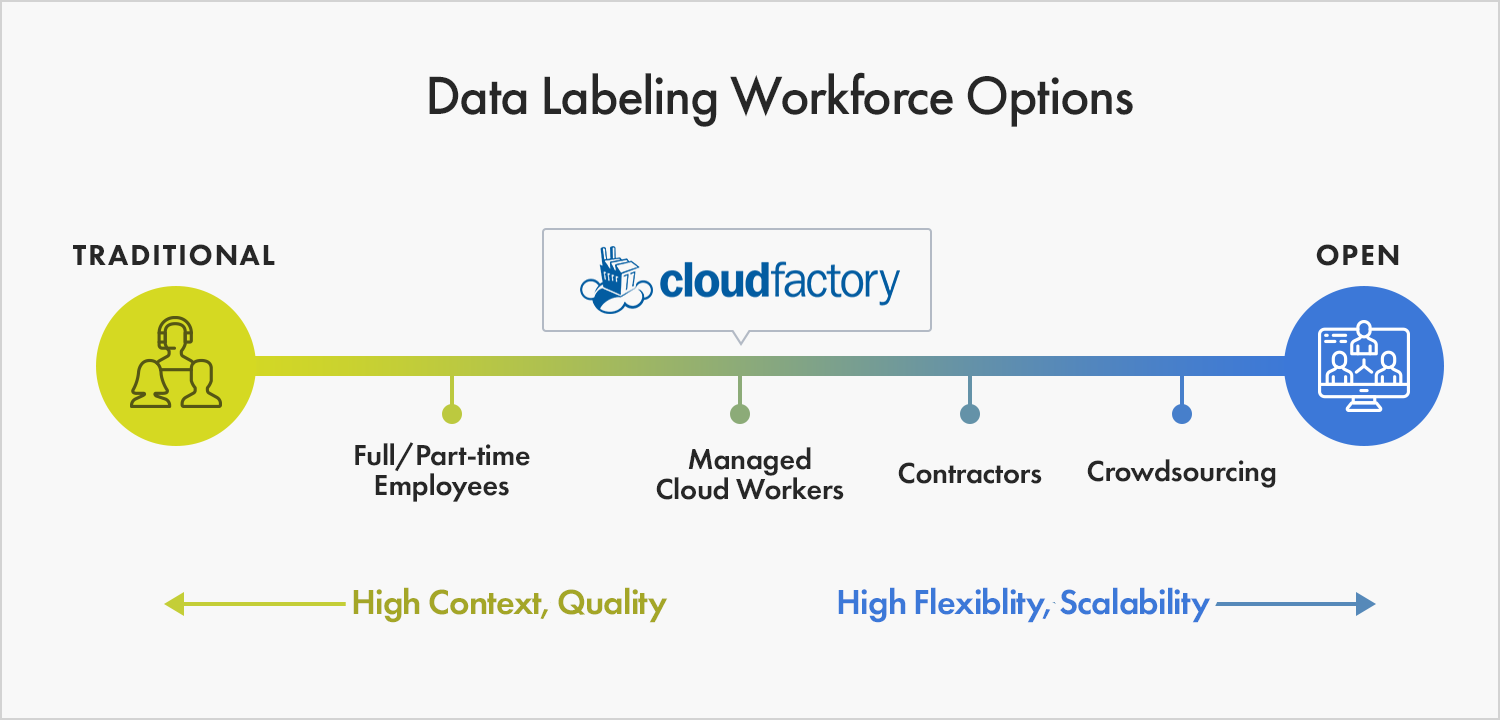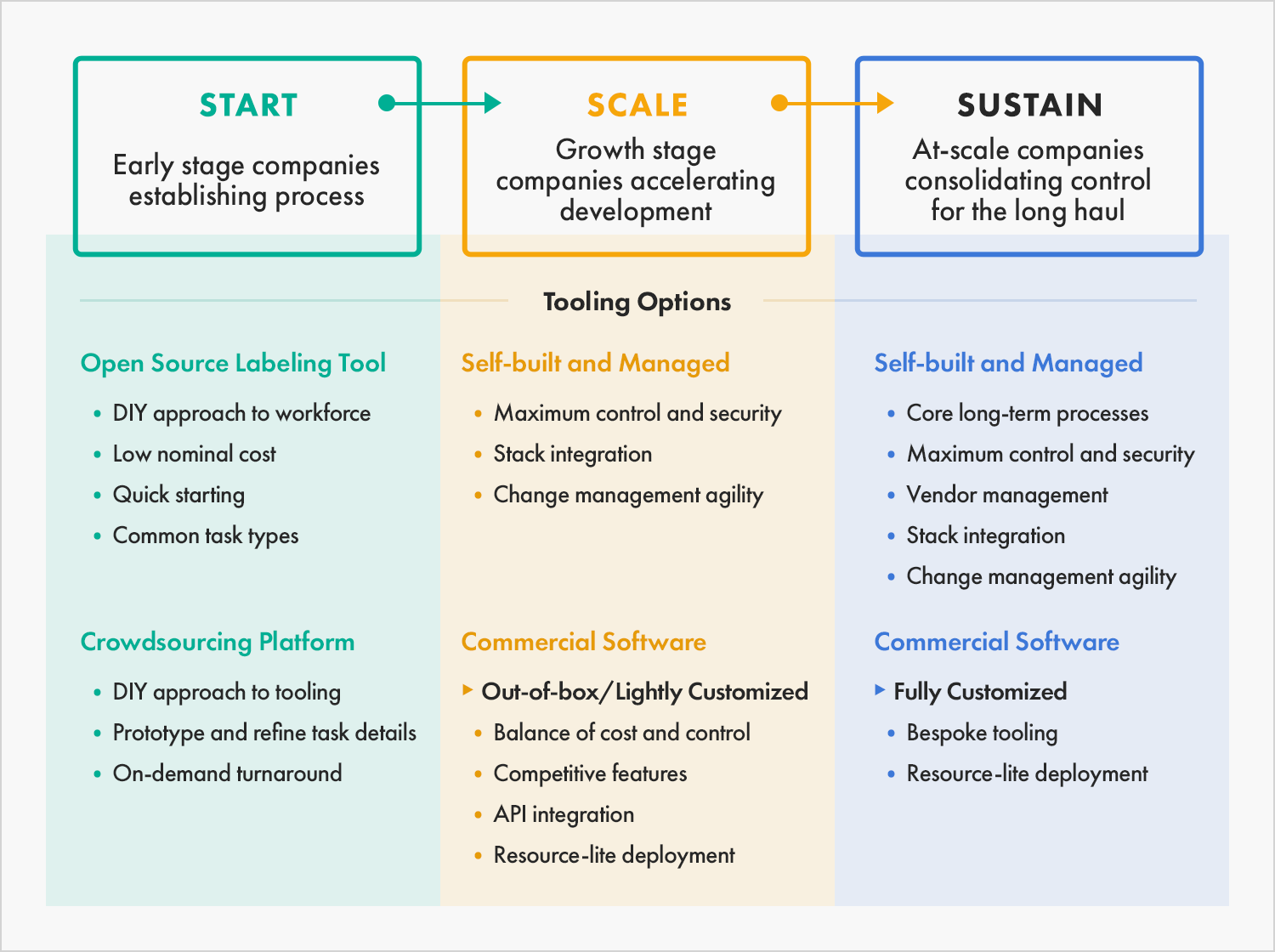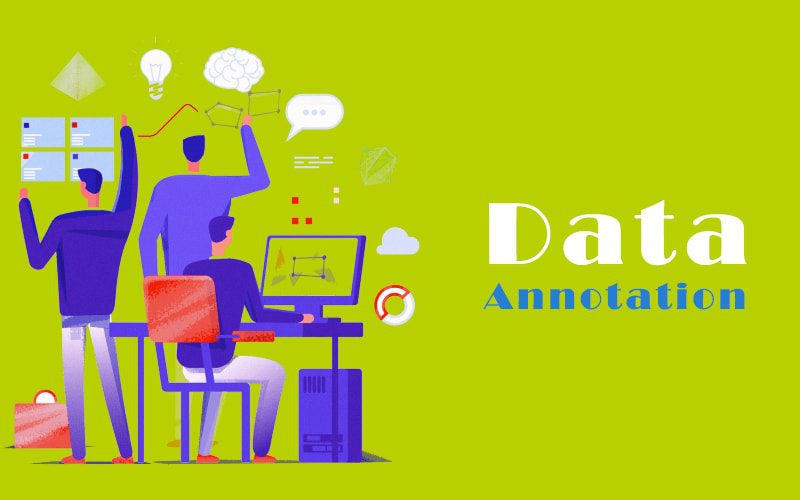The rise data of the artificial intelligence industry has led to an increasing demand for annotation in the AI field. For example, if you want AI to accurately identify pictures, you need to manually label similar pictures in the set, so that the algorithm and the image can be judged and identified by correlation. And this process requires a lot of pictures to allow AI to learn a model. labeling is the most basic work in this process, so what is labeling? Why do we need labeling? Let’s introduce it below
What is Labeling?

labeling is the process of labeling and detecting samples, labeling primary such as pictures and videos that require computer machine learning, allowing the computer to continuously identify the characteristics of these primary , and finally allowing the computer to identify independently , to provide a large amount of training for artificial intelligence algorithms to be called by machine learning
In the world of artificial intelligence and machine learning, labeling plays a crucial role in training algorithms and improving the accuracy of models. labeling, also known as annotation, is the process of assigning tags or labels to raw to provide meaningful information for machine learning algorithms. In this article, we will explore the concept of labeling, its importance, and the different methods used in this process.
labeling involves human annotators manually reviewing and analyzing to assign relevant labels or tags. The labeled serves as a reference or ground truth for machine learning algorithms to learn patterns, make predictions, and perform tasks accurately. It helps algorithms recognize and understand patterns, objects, or concepts within the , enabling them to make informed decisions and provide accurate outputs.
The process of labeling requires expertise and domain knowledge. Annotators are trained to understand the specific requirements of the task and apply consistent labeling practices. They follow guidelines and predefined rules to ensure uniformity and maintain the quality of the labeled .
There are various types of labeling methods, depending on the nature of the and the task at hand:
- Image and Object Annotation:
- Image Classification: Annotators assign labels or tags to images based on their content, such as identifying objects, scenes, or specific features.
- Object Detection: Annotators draw bounding boxes around objects of interest within images to train algorithms to detect and locate similar objects in new.
- Semantic Segmentation: Annotators assign pixel-level labels to identify and classify different regions or objects within an image.
- Text Annotation:
- Named Entity Recognition: Annotators identify and tag specific entities within text, such as names, organizations, locations, or dates.
- Sentiment Analysis: Annotators classify text according to sentiment or emotion, such as positive, negative, or neutral.
- Text Categorization: Annotators assign predefined categories or topics to classify text documents based on their content.
- Speech and Audio Annotation:
- Speech Recognition: Annotators transcribe spoken words or phrases to create a labeled for training speech recognition algorithms.
- Speaker Diarization: Annotators segment audio recordings based on different speakers’ voices, enabling algorithms to differentiate between speakers.
- Emotion Recognition: Annotators label audio recordings based on the emotional content expressed, such as happiness, sadness, or anger.
labeling is essential for the successful development and deployment of machine learning models. Here are some reasons why labeling is important:
- Training Quality: High-quality labeled is crucial for training accurate and reliable machine learning models. Well-labeled ensures that algorithms learn the correct patterns and make accurate predictions.
- Model Performance Improvement: Properly labeled helps improve the performance of machine learning models over time. As models are trained on more labeled, they become more accurate and capable of handling real-world scenarios.
- Human Insight and Expertise: Human annotators bring their domain knowledge and expertise to the labeling process. Their understanding of context, nuances, and complex patterns helps create more meaningful and accurate labels.
- Error Detection and Correction: labeling allows for error detection and correction in the training. Annotators can identify and rectify any inconsistencies, errors, or biases in the, ensuring the model is trained on accurate and unbiased information.
While labeling offers numerous benefits, it also comes with challenges. Some of these challenges include ensuring inter-annotator agreement, managing large-scale labeling projects, maintaining consistency across annotators, and addressing subjective labeling tasks. Effective quality control measures, clear guidelines, and regular communication with annotators are essential to overcome these challenges.
In conclusion, labeling is a critical process in the field of machine learning. It involves human annotators assigning meaningful labels to raw , providing the necessary information for training algorithms. Properly labeled improves model accuracy, enhances performance, and enables algorithms to make informed decisions. By leveraging human insight and expertise, labeling plays a vital role in the development of accurate and reliable machine learning models.
Why is labeling needed?
The degree of implementation of artificial intelligence AI depends on the used for learning and training. The quantity and quality of directly determine the success or failure of AI algorithms. Therefore, when building an Al model, a large amount of training needs to be continuously inflowed to enrich the future learning of the AI model, that is, supervised learning
In the field of machine learning, labeling plays a crucial role in training accurate and reliable models. labeling, also known as annotation, involves assigning meaningful tags or labels to raw , enabling machine learning algorithms to learn patterns and make accurate predictions. Without proper labeling, machine learning algorithms would struggle to understand and interpret the underlying information within the . In this article, we will explore the importance of labeling and why it is needed in machine learning.
- Supervised Learning: labeling is essential in supervised learning, where algorithms learn from labeled examples to make predictions on new, unlabeled. By providing labeled as a reference, algorithms can identify patterns, relationships, and correlations within the. Labeled serves as the foundation for training models, allowing them to generalize and make accurate predictions on unseen.
- Training Quality: High-quality labeled is crucial for training accurate and reliable machine learning models. labeling ensures that algorithms learn the correct patterns and make accurate predictions. Without proper labeling, algorithms may struggle to understand the desired outcomes or may learn incorrect patterns, leading to unreliable predictions and poor model performance.
- Learning from Human Expertise: labeling incorporates human expertise and domain knowledge. Annotators bring their understanding of the, context, and relevant features to the labeling process. Their expertise helps in accurately assigning labels and capturing nuanced information that might be challenging for algorithms to infer on their own. Human annotation bridges the gap between raw and machine learning algorithms, enhancing their learning capabilities.
- Task-Specific Information Extraction: labeling allows algorithms to extract task-specific information from the. Whether it’s identifying objects in images, recognizing named entities in text, or detecting anomalies in financial transactions, labeling provides the necessary annotations that guide algorithms in extracting meaningful insights. Labeled serves as a reference point for algorithms to understand the specific features or attributes relevant to the task at hand.
- Algorithm Training and Evaluation: labeling is crucial for both training and evaluating machine learning models. Labeled serves as the training set that allows algorithms to learn and adjust their parameters to make accurate predictions. Additionally, labeled forms the basis for evaluating model performance and assessing its effectiveness. Without proper labeling, it would be challenging to measure and compare the performance of different models accurately.
- Transfer Learning and Pretrained Models: Labeled plays a vital role in transfer learning and leveraging pretrained models. Transfer learning involves reusing knowledge gained from one task to improve performance on another related task. Labeled allows models to learn general features and patterns that can be transferred and fine-tuned for specific tasks. Pretrained models, trained on large annotated, serve as a starting point for various applications, saving time and resources in training from scratch.
- Bias Detection and Mitigation: labeling helps in detecting and addressing biases in the. Annotators can identify potential biases and ensure fair and unbiased labeling practices. By detecting and mitigating biases, labeling promotes ethical and inclusive machine learning models, reducing the risk of unfair outcomes or discriminatory behavior.
In conclusion, labeling is crucial in machine learning as it provides labeled that serves as a reference for training accurate and reliable models. Labeled helps algorithms understand patterns, extract task-specific information, and make accurate predictions. It incorporates human expertise, enables transfer learning, facilitates model evaluation, and aids in bias detection and mitigation. By recognizing the importance of labeling, we can ensure the development of trustworthy and effective machine learning models that drive advancements and improve various applications across industries.
Application scenarios of annotation:
With the rise of digital image processing and computer platforms, annotation is gradually integrated into the modern digital field, playing a key role in banking, finance, social media, smart agriculture, digital commerce and other scenarios. The growth of digital content on various business platforms requires the processing of a large amount of user such as images, videos, and texts, all of which cannot be separated from the basic support of annotation
annotation, also known as labeling, is a critical process in machine learning that involves assigning meaningful tags or labels to raw . This labeled serves as a crucial resource for training algorithms, enabling them to learn patterns and make accurate predictions. annotation finds applications across a wide range of domains, contributing to advancements in fields such as healthcare, autonomous vehicles, e-commerce, and more. In this article, we will explore some application scenarios of annotation and its impact in various domains.
- Healthcare and Medical Imaging: annotation plays a vital role in healthcare and medical imaging applications. Radiologists and medical experts annotate medical images to identify and label specific anatomical structures, lesions, or abnormalities. This labeled is used to train machine learning models for tasks such as disease diagnosis, tumor detection, or treatment planning. annotation enhances the accuracy and efficiency of medical imaging technologies, supporting early detection, precise diagnosis, and improved patient outcomes.
- Autonomous Vehicles: Autonomous vehicles heavily rely on annotation for training perception systems and decision-making algorithms. Annotators label large of images or videos captured by vehicle sensors, such as cameras or LiDAR, to identify objects, road markings, traffic signs, and pedestrians. This annotated helps autonomous vehicles understand and navigate the surrounding environment, enabling them to make real-time decisions for safe and reliable autonomous driving.
- Natural Language Processing (NLP): NLP applications require annotation for tasks like sentiment analysis, named entity recognition, text classification, and machine translation. Annotators label textual, such as social media posts, customer reviews, or news articles, to train NLP models. This annotated enables algorithms to understand and extract meaningful information from text, facilitating applications like chatbots, language translation, sentiment analysis for brand monitoring, or information retrieval systems.
- E-commerce and Recommender Systems: annotation is instrumental in e-commerce applications, particularly for recommender systems. Annotators label customer behavior, such as purchase history, browsing patterns, or preferences, to create personalized recommendations. These annotations power recommendation algorithms, enabling e-commerce platforms to deliver tailored product suggestions, enhance customer engagement, and drive sales.
- Robotics and Industrial Automation: Robotics and industrial automation heavily rely on annotation to enable machines to perceive and interact with the environment accurately. Annotators label objects, grasp points, or manipulate actions to train robots for tasks such as object recognition, pick-and-place operations, or assembly line automation. annotation enhances the capabilities of robots, enabling them to perform complex tasks with precision and efficiency.
- Financial Services and Fraud Detection: annotation is critical in the field of financial services, especially for fraud detection and risk assessment. Annotators label financial transaction to identify patterns, anomalies, or suspicious activities. This annotated trains machine learning models to detect fraudulent transactions, mitigate risks, and enhance security in banking, insurance, or credit card industries.
- Agricultural and Environmental Monitoring: annotation is valuable in agricultural and environmental monitoring applications. Annotators label satellite or drone imagery to identify crop types, assess crop health, monitor vegetation growth, or identify environmental changes. This annotated enables precision agriculture, environmental conservation, and land management, leading to optimized resource utilization and sustainable practices.
These application scenarios highlight the significance of annotation in diverse domains. By leveraging annotated , machine learning algorithms can unlock insights, improve decision-making, and create innovative solutions in various fields. Effective annotation practices, including clear guidelines, quality control measures, and expert annotators, contribute to the accuracy, reliability, and success of machine learning applications.
In conclusion, annotation is a crucial process that empowers machine learning in numerous domains. Whether it is healthcare, autonomous vehicles, NLP, e-commerce, robotics, financial services, or environmental monitoring, annotation plays a pivotal role in training algorithms and enabling accurate predictions. The application scenarios of annotation demonstrate its broad impact in driving advancements, optimizing processes, and improving outcomes in diverse industries.
What are the types of data labeling?
There are many types of labeling, such as frame labeling, classification labeling, area labeling, and point labeling. Basic annotation types include computer vision, speech engineering, and natural language processing
1. Computer vision: drawing frame labeling, semantic segmentation, 3D point cloud labeling, key point labeling, line labeling, 2D/3D fusion labeling, target tracking, image classification, etc
2. Natural language processing: OCR transcription, text information extraction, NLU sentence generalization, part-of-speech tagging, sentiment judgment, intention judgment, machine translation, anaphora resolution, slot filling, etc

3. Voice engineering: ASR voice transcription, voice emotion judgment, voiceprint recognition and labeling, voice cutting, etc
labeling, also known as annotation, is a critical process in machine learning that involves assigning meaningful tags or labels to raw . The labeled serves as a reference for training algorithms, enabling them to learn patterns and make accurate predictions. There are various types of labeling methods, each tailored to specific types and machine learning tasks. In this article, we will explore the common types of labeling and their applications in machine learning.
- Image and Object Annotation: Image and object annotation involve labeling images to identify and classify objects or regions within the images. Some common types of image and object annotation include:
- Image Classification: Annotators assign labels or tags to images based on their content, such as identifying objects, scenes, or specific features. This type of annotation is widely used in tasks like image recognition, content filtering, or visual search.
- Object Detection: Annotators draw bounding boxes around objects of interest within images. This type of annotation enables algorithms to detect and locate similar objects in new. Object detection is commonly used in applications like autonomous driving, object tracking, or surveillance systems.
- Semantic Segmentation: Annotators assign pixel-level labels to identify and classify different regions or objects within an image. This fine-grained annotation helps algorithms understand the boundaries and relationships between objects. Semantic segmentation is used in applications such as medical image analysis, autonomous robotics, or image editing.
- Text Annotation: Text annotation involves labeling textual to provide structure and meaning. Common types of text annotation include:
- Named Entity Recognition (NER): Annotators identify and tag specific entities within text, such as names, organizations, locations, or dates. NER annotation is used in applications like information extraction, chatbots, or text summarization.
- Sentiment Analysis: Annotators classify text according to sentiment or emotion, such as positive, negative, or neutral. Sentiment analysis annotation is widely used in applications like social media monitoring, customer feedback analysis, or brand reputation management.
- Text Categorization: Annotators assign predefined categories or topics to classify text documents based on their content. This type of annotation is used in tasks like document classification, content filtering, or topic modeling.
- Speech and Audio Annotation: Speech and audio annotation involve labeling spoken words, audio recordings, or sound segments. Some common types of speech and audio annotation include:
- Speech Recognition: Annotators transcribe spoken words or phrases to create a labeled for training speech recognition algorithms. Speech recognition annotation is used in applications like virtual assistants, transcription services, or voice-controlled systems.
- Speaker Diarization: Annotators segment audio recordings based on different speakers’ voices, enabling algorithms to differentiate between speakers. Speaker diarization annotation is used in applications like speaker identification, call center analytics, or forensic audio analysis.
- Emotion Recognition: Annotators label audio recordings based on the emotional content expressed, such as happiness, sadness, or anger. Emotion recognition annotation is used in applications like voice assistants, sentiment analysis, or customer experience analysis.
- Other Types of Annotation: There are additional types of annotation that are domain-specific or cater to unique types:
- Video Annotation: Annotators label videos to identify and track objects, perform action recognition, or annotate temporal events.
- 3D Point Cloud Annotation: Annotators label 3D point clouds obtained from LiDAR or depth sensors to annotate objects, create maps, or enable autonomous navigation.
- Time Series Annotation: Annotators label time series to identify patterns, anomalies, or specific events within the.
Each type of labeling requires specific expertise, guidelines, and tools. Annotators follow these guidelines to provide accurate and consistent annotations that train machine learning models effectively.
In conclusion, labeling encompasses various types, each suited to different types and machine learning tasks. Image and object annotation, text annotation, speech and audio annotation, as well as other specialized types, play a vital role in training algorithms and enabling accurate predictions. By leveraging the expertise of human annotators and utilizing appropriate annotation techniques, organizations can unlock the full potential of their for machine learning applications.
